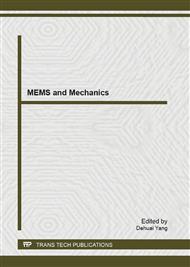[1]
H.A.C. Tilmans, M. Elwenspoek, J.H.J Fluitman, Micro resonant force gauges, Sensors and Actutors A. 30 (1992) 35-53.
DOI: 10.1016/0924-4247(92)80194-8
Google Scholar
[2]
N. Yazdi, F. Ayazi, K. Najafi, Micromachined inertial sensors, Proceedings of the IEEE. 86 (1998) 1640-1659.
DOI: 10.1109/5.704269
Google Scholar
[3]
M. Bao, H. Yang, H. Yin and Y. Sun, Energy transfer model for squeeze-film air damping in low vacuum, J. Micromech. Microeng. 12 (2002) 341–347.
DOI: 10.1088/0960-1317/12/3/322
Google Scholar
[4]
Z. Hao, A. Erbil, F. Ayazi, An analytical model for support loss in micromachined beam resonators with in-plane vibrations, Sensors and Actuators A. 109 (2003) 156-164.
DOI: 10.1016/j.sna.2003.09.037
Google Scholar
[5]
A.H. Nayfeh, M.I. Younis, Modeling and simulations of thermoelastic damping in microplates, Journal of Micromechanical and Microengineering. 14 (2004) 1711-1717.
DOI: 10.1088/0960-1317/14/12/016
Google Scholar
[6]
C. Zener, Internal friction in solids: I. Theory of internal friction in reeds, Phys. Rev. 52 (1937) 230- 235.
DOI: 10.1103/physrev.52.230
Google Scholar
[7]
C. Zener, Internal friction in solids: II. General theory of thermoelastic internal friction, Phys. Rev. 53 (1938) 90-99.
DOI: 10.1103/physrev.53.90
Google Scholar
[8]
J.R. V.L. Filler, Y. Kim, Uncooled IR imaging array based on quartz resonators, IEEE J. Mricoelectromech. Syst. 5 (1996) 131-137.
DOI: 10.1109/84.506201
Google Scholar
[9]
J. Liu, D.T. Martin, T. Nishida, Harmonic balance nonlinear identification of a capacitive dual-backplate MEMS microphone, Journal of Microelectromechanical system. 17 (2008) 698-708.
DOI: 10.1109/jmems.2008.922067
Google Scholar
[10]
S. Vengallatore, Analysis of thermoelastic damping in laminated composite micromechanical beam resonators, Journal of Micromechanics and Microengineering. 15 (2005) 2398-2404.
DOI: 10.1088/0960-1317/15/12/023
Google Scholar
[11]
J. E. Bishop, V. K. Kinra, Elastothermodynamic Damping in Laminated Composites. Int. J. Solids Structures. 34 (1997) 1075-1092.
DOI: 10.1016/s0020-7683(96)00085-6
Google Scholar
[12]
Heinz Parkus, Thermoelasticity, Spriner-verlag, New York, 1976.
Google Scholar
[13]
J.L. Nowinski, Theory of thermoelasticity with applications, Sijthoff &Noordhoff International publishers, Alphen AAN Den Rijn, 1978.
DOI: 10.1080/01495737908962396
Google Scholar
[14]
M.N. Ozisik, Heat conduction, John Wiley &Sons, New York, 1980.
Google Scholar
[15]
I.R.shames, C.L. DYM, Energy and finite element methods in structural mechanics, Hemisphere publishing corporation, Washington, 1985.
Google Scholar


